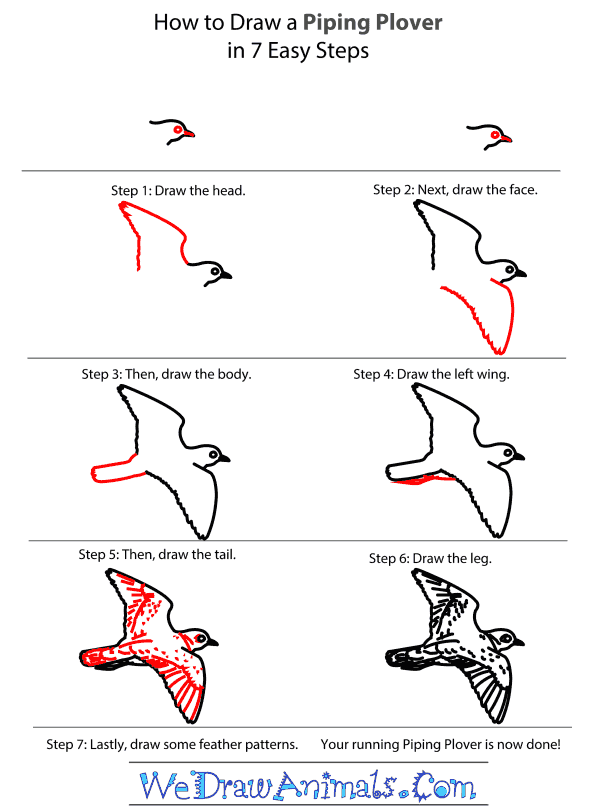In this quick tutorial you'll learn how to draw a Piping Plover in 7 easy steps - great for kids and novice artists.
The images above represent how your finished drawing is going to look and the steps involved.
Below are the individual steps - you can click on each one for a High Resolution printable PDF version.
At the bottom you can read some interesting facts about the Piping Plover.
Make sure you also check out any of the hundreds of drawing tutorials grouped by category.
How to Draw a Piping Plover - Step-by-Step Tutorial
Step 1: First, draw the narrow, pointed beak of the Piping Plover. Then, use a curved line to draw the rounded head of the bird.
Step 2: Draw a tiny circle for the eye of the bird. Fill in the beak of the Piping Plover.
Step 3: Starting from the head, draw a curved line and then draw a slanting line from the curve. This is the outline of the upper part of the Piping Plover's left wing. Using a wavy line, follow the bend in the previous line to draw the lower edge of the bird's wing as shown in the image.
Step 4: Draw the right wing of the Piping Plover in the same way as the left wing. Leave some blank space between the ends of the wings for the bird's tail.
Step 5: Draw the flat tail of the Piping Plover using two lines. Use a wavy line to draw the edges of the tail feathers.
Step 6: Draw a stretched S-shaped line just below the tail to show the leg of the Piping Plover.
Step 7: To finish the drawing, add short, slanting lines and dots on the wings and tail of the Piping Plover to show the markings on its feathers. After you complete your drawing of the Piping Plover, you can color it.
Interesting Facts about the Piping Plover (Charadrius melodus):
The Piping Plover is a tiny shore bird about six or seven inches long. It is pale tan in color, with a black or brown band around its chest and black spots at the tip of its beak and its forehead. Its legs and beak are otherwise bright yellow.
Did you know?
- The Piping Plover is considered an endangered species in some areas, and a near threatened species internationally.
- The Piping Plover creates its nests on the ground.
- The pale brown color of the Piping Plover helps it blend in with the beach sands where it lives.
- Piping Plovers don’t hang out in big groups. They are usually seen in pairs or groups of three or four.
- Piping Plovers sometimes jiggle their feet to scare little insects and crustaceans out from hiding so they can catch and eat them.
Part of why the Piping Plover is threatened with extinction is that human beings like the same places Piping Plovers do – the beach! Off-road vehicles, dogs and families having fun at the beach can destroy important Piping Plover habitats or even nests without meaning to or realizing it. This is why conservations are seeking to find and keep safe the areas where Piping Plovers live, especially at the time of year when the new chicks are born.








